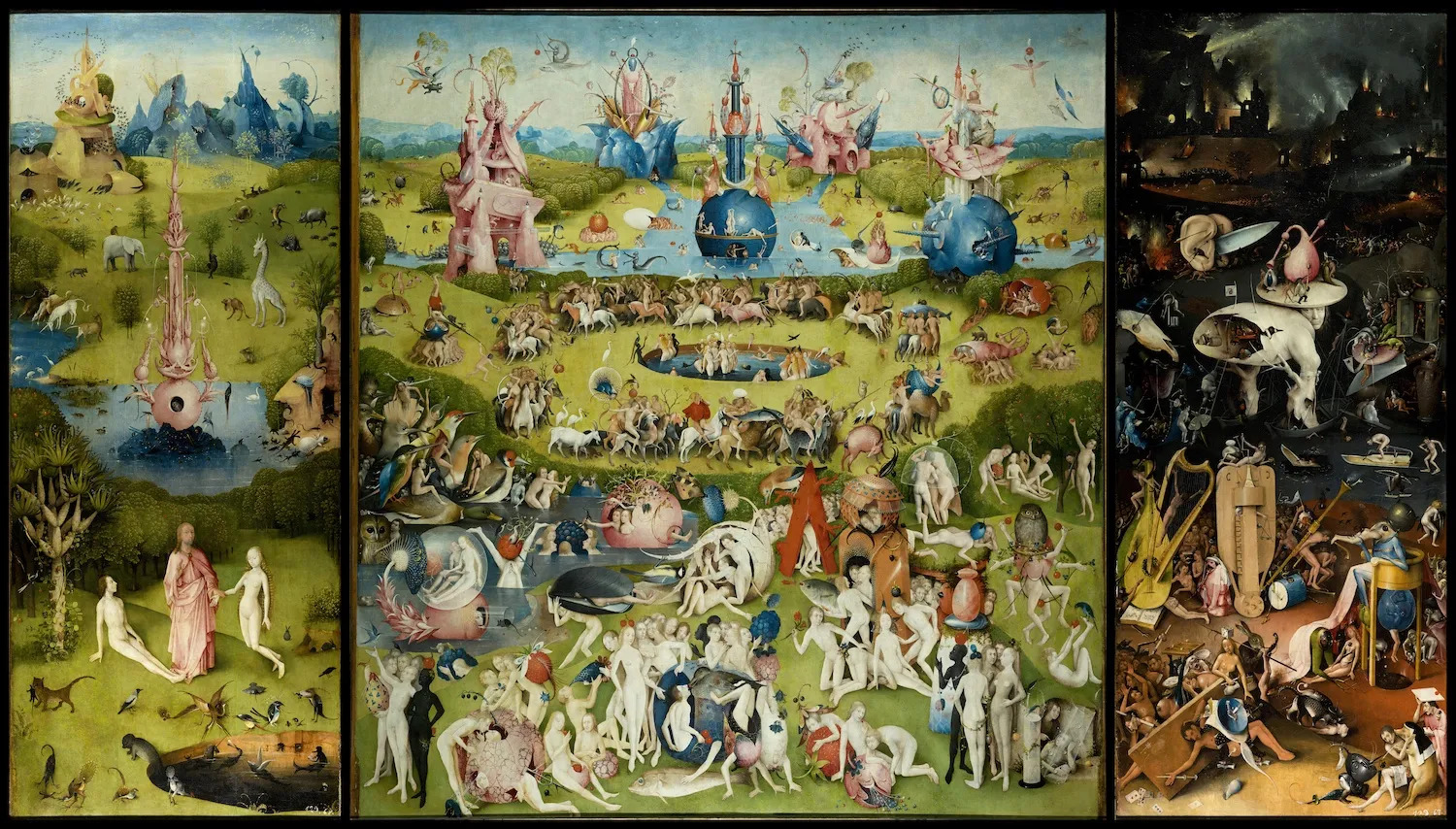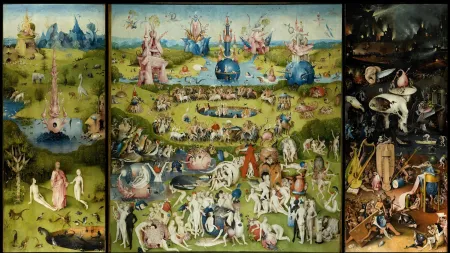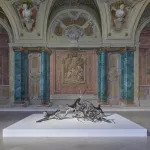
The word most often used to describe The Garden of Earthly Delights (c. 1490–1510), surreal, is, in fact, an anachronism. No such term existed when it was created, and there was nothing about it that didn’t comport with the thinking of the time, when corruption of the flesh was an ever-present hazard and damnation an ever-present prospect. God and Satan, angels and demons, were taken as real by nobles and peasants alike, and this was no less true of the painting’s author, Hieronymus Bosch (c. 1450–1516).
A folding triptych done in oil on oak boards, The Garden depicts the divide between heaven and hell, the terrestrial and the celestial. It serves as a kind of treatise on the cosmology of the soul, a representation of accepted fact much as the big bang is today—and, in terms of its visual impact, just as expansive. Though it appears confounding and disjointed to modern eyes, The Garden of Earthly Delights is as consistent an example of the medieval world view as any in art history.
Nonetheless, during the 20th century Bosch was embraced by the Surrealists, who considered him one of their own. The movement’s majordomo, André Breton, heralded Bosch as a “singer of the unconscious” whose chaotic work provided a template for automatism, which stipulated that artistic expression could be accessed by surrendering “any control exercised by reason.”
Salvador Dalí was particularly indebted to Bosch, appropriating a small detail from The Garden (a rock formation resembling a human profile with a closed eye, an illusion conjured by the presence of a small, shelled creature trailing eyelash-like tendrils) for paintings such as The Great Masturbator (1929) and The Persistence of Memory (1931). In essence, what Breton and Dalí saw in Bosch became impossible to unsee, especially after the perceived disconnects of Bosch’s vision began to mirror the existential uncertainties of modernity.
About Bosch himself, we know little. He was born Jheronimus van Aken in ‘s-Hertogenbosch, a Dutch town that was then in a part of the Holy Roman Empire called the Duchy of Brabant. He belonged to a family of painters spanning six generations who were believed to have emigrated from Aachen, Germany. Although he signed some of his work (unusual for his time) with his original first name, he changed it to the spelling more familiar to us, appending the end of his birthplace to complete his moniker.
There’s a drawing of Bosch that appears to be a self-portrait, and it is widely believed that the face looming large in the hell portion of The Garden depicts the artist. Otherwise, there’s no record of him other than brief mentions in various public documents, like the account books of a religious confraternity, the Illustrious Brotherhood of Our Blessed Lady, to which he belonged.
Measuring more than 6 by 12 feet when unfurled, The Garden approaches the scale of altarpieces found in churches, but since its first owner was one Engelbert II, Count of Nassau, it was likely commissioned for private devotion. Evidently Engelbert got more than he paid for, as The Garden is indeed the product of a febrile imagination.
Much as in The Wizard of Oz, the 1939 MGM classic that starts out in black and white before exploding into Technicolor when Dorothy arrives in the magical kingdom, The Garden—which follows a narrative like a movie or a book—begins in grisaille when closed and opens to reveal a stunning chromatic palette. The exterior pictures the third day of the Creation, when the waters were separated from the earth and the Garden of Eden was established. The world is seen in grays, a fragile soap bubble floating in the void while God the Father hovers above, a tiny deity admiring his almighty handiwork. Two passages from the Bible—“For he spake, and it was done” and “For he commanded, and they were created”—are inscribed in Latin across the top.
Inside, Bosch’s narrative starts on the right-hand panel with a scene of Eden before the Fall, posing Adam and Eve on either side of a beatific Christ. They are in a verdant landscape populated with various types of flora and fauna as well as bizarre architectural follies. Structures in bright pink and blue abound, heightening the sense that we’re in an otherworldly place.
This vista continues into the central panel, the largest of the three, which features a veritable circus of carnality. Scores of naked men and women engage in debauchery that’s admittedly more implied than explicit in Bosch’s rendering. Their activities are meant as the logical outcome of the Expulsion, a theme typically presented under a cloud of shame and disgrace that becomes humanity’s destiny. Here, however, there’s no shame; in fact, given the number of revelers enjoying themselves in a foregrounded pool and a larger lake behind it, the message seems to be one of cheerful invitation.
Of course there’s a catch, as this section is followed by The Garden’s most famous: Bosch’s depiction of hell in all its infernal fury. Bosch takes apparent delight in devising punishments for the condemned, the most iconic being the bird-headed chimera gobbling up figures before excreting them into a bottomless cesspit. Seated like a monarch on a throne and wearing a chamber pot for a crown, he’s the regal instrument for transmogrifying mortal clay into eternal waste. Other images—a knife blade between a pair of giant ears; the aforementioned likeness of the artist looking back at us over an enormous haunch that’s part animal, part tree, and part proscenium for a seemingly random slice of domestic life—are just as indelibly etched.
Although many have offered theories about Bosch’s allegory, its overall lesson appears to be quite simple: Thanks to Adam and Eve, we’re all born into sin and can’t help succumbing to its temptations despite the unpleasant consequences.
Still, if not for Surrealism, one might wonder how different our current reception of Bosch’s masterpiece might be. As it is, Breton’s embrace of Bosch’s achievement gives us some means, however misguided, to draw out its mysteries even as they remain beyond reach.
Hybrid Immortality: Rona Pondick’s Fantastical Self-Portraits
Hieronymus Bosch: A Mysterious Master’s Early Life and Major Works

Joby and Archer Take Center Stage in the Race to Make eVTOL Travel a Reality

Chris McMillan Launches Namesake Hair Care Line at Sephora, Bringing Decades of Expertise to Styling Products

iPhone 17 may have a surpring new color that’s like nothing we’ve seen before

Every Division I School’s Revenue-Sharing Decision for 2025-26



